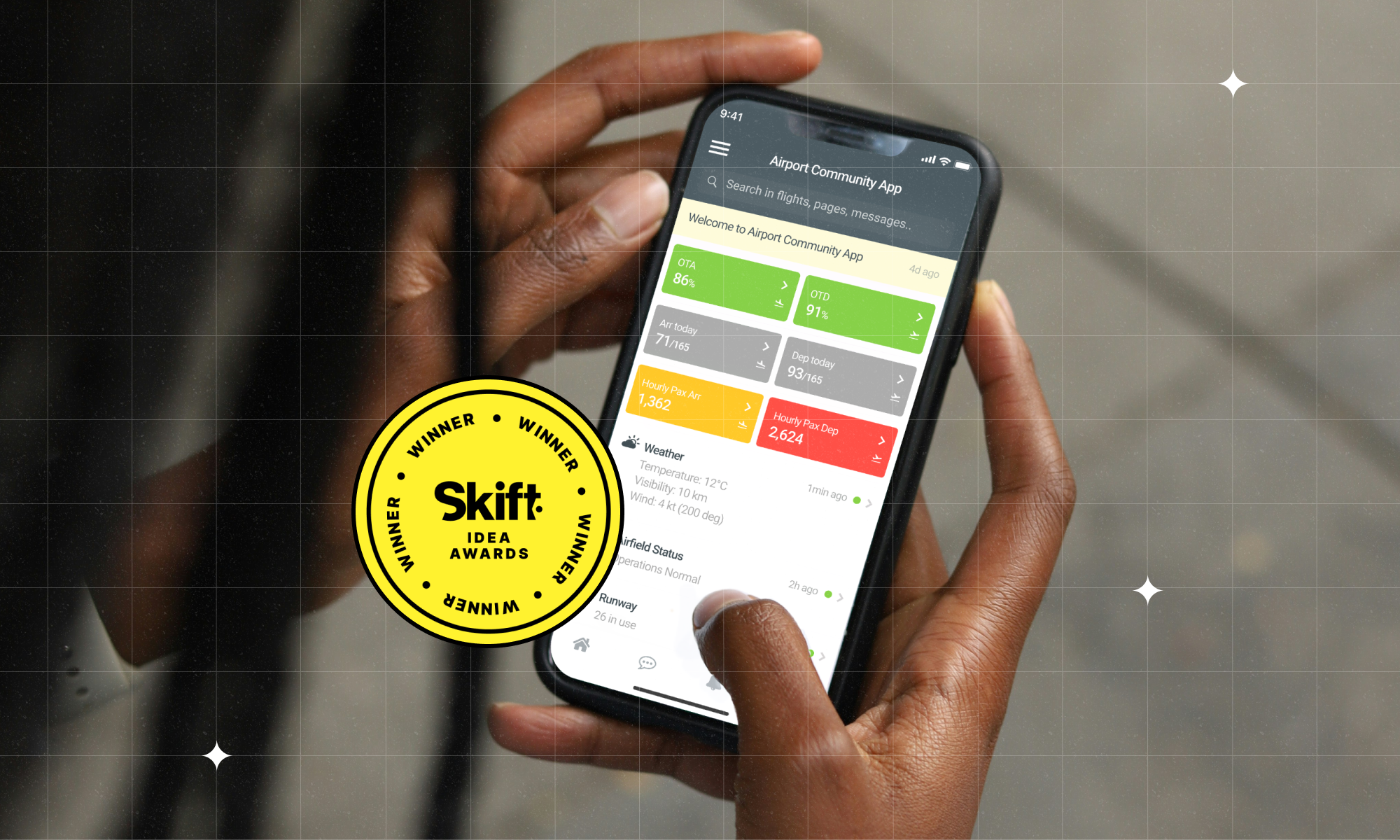The digital transformation process drives the overhaul of existing operational standards in the aviation industry and even if efficiency and safety continue to be paramount, there is an additional aspect of airport operations that is quickly becoming critical - collaboration. As the backbone of airport operations and the cornerstone of digitisation, AODB solutions have a key role to play in fostering close collaboration between all airport stakeholders and providing them with a centralised hub for communication in order to streamline airport operations. Consequently, acting as a collaborative platform is no longer an innovative feature in AODB platforms but rather a direction in which all such solutions should evolve - and this is why we have placed a lot of emphasis on providing SkyCore AODB users with features to facilitate collaboration between the wide variety of stakeholders.
In addition to fostering collaboration, another pivotal aspect of AODB solutions lies in the realm of prediction. As aviation undergoes a digital transformation, the ability to proactively address operational challenges is increasingly vital and prediction becomes a cornerstone in the evolution of AODB solutions. SkyCore is equipped with these predictive capabilities to leverage the vast amount of data available in airports in order to forecast trends, anticipate disruptions, and ultimately enable airports to stay one step ahead in this increasingly dynamic landscape.
Collaboration starts locally - SkyCore’s A-CDM Timeline
The A-CDM Process is a widely known initiative that enables real-time collaboration and data sharing among all airport stakeholders, providing them with the necessary tools for synchronised decision-making and more efficient resource allocation. Given the centralised role, AODB solutions play in fostering a collaborative environment, integrating ACDM capabilities and milestones in our SkyCore AODB solution was a natural choice, aiming to empower airports to better manage operational schedules and resource allocation, and reduce delays and operational disruptions.
SkyCore AODB provides a detailed A-CDM timeline for all flights available in the system, with all individual milestones displayed and configured as per the airport’s own specific requirements. The focus of this timeline is on the milestone approach, pre-departure sequence and collaborative management of flight updates in the turnaround process. With the help of the Rule Engine Editor module that is part of SkyCore, individual alerts can be set up for all A-CDM milestones, which can inform stakeholders when a particular milestone is not met. Importantly, these milestones are automatically completed as operational data comes into the application, regardless of whether this is from a user input or an inbound data integration. Additionally, SkyCore’s close integration with the AirportLabs Data Router enables the system to send operational triggers such as departure planning messages to downstream systems, whenever any of the configured milestones are completed.
And expands globally - SkyCore’s AOP module
The A-CDM capabilities provided by SkyCore AODB focus on the common situational awareness of all stakeholders involved in managing airport operations, providing them with real-time information for better decisions. Despite its highly useful capabilities, the A-CDM process is more focused on the tactical issues that might appear on D-0 (the actual day of operations) and on the collaboration between users at a local level. There is a natural extension of this process with a wider scope compared to A-CDM - that is the Airport Operating Plan (AOP). As a logical addition to its A-CDM capabilities, SkyCore provides these specific capabilities in its dedicated SkyCore AOP module. A customised instantiation of this module can be enabled for each implementation of SkyCore, based on the integration of critical airport systems and data interfaces available.
Firstly, as a single, common and collaboratively-agreed rolling plan, SkyCore’s AOP module aims to coordinate the activities of all airport stakeholders, much like the A-CDM process. However, an important difference is that this module is less focused on the tactical issues of D-0: the rolling plan is initially designed months before the day of operations based on the operational schedules, contextual information about airport resources and other relevant activities, such as maintenance plans, sporting events or logistical works that can impact operations - enabling all relevant parties to contribute in a collaborative environment.
Secondly, the process of refinement that the AOP continuously undergoes over several months greatly fosters the collaboration of all airport partners. As further operational data and contextual information become available, this provides increased accuracy and enables the continual refinement of the operating plan through the close coordination between the operational stakeholders. Any operational updates are communicated to all involved operators and as airports approach the day of operations and more detailed information becomes available, the refined operational scenarios along with their impact on key performance indicators can be evaluated. This enables any operational player to keep a close eye on their operations' efficiency and make any tactical adjustments if necessary.
Finally, SkyCore’s AOP module also enables close collaboration between airports globally, at the network level: the airports put forward their own individual AOPs as primary information tools, and these feed into a NOP - the Network Operational Plan, which is a comprehensive global plan for a network of airports. The higher-scale perspective provided by the NOP ensures a common network-wide situational awareness and a close coordination between the various network actors - airports, air navigation service providers, airlines, ground handlers and others. The exchange of data in the network consisting of individual airports ultimately leads to better predictability and improved rolling plans at both airport and network levels.
Predictive Capabilities - Leveraging Data
Due to its early inception and continuous refinement, a large amount of operational data and contextual information is processed in SkyCore’s AOP module. Consequently, this enables SkyCore to leverage the power of data analytics in order to derive relevant information about historical trends and patterns and use the analytical conclusions to enhance its operational predictions. The predictive approach to airport operations enabled by the AOP module allows any stakeholder to constantly evaluate the impact of changes in schedules, operating conditions, or unforeseen circumstances on the efficiency of operations. Importantly, these enhanced predictive capabilities can then be applied to derive more accurate refinements of the rolling plans in the future, and with this information easily accessible, operators can make quick, informed decisions in order to minimise disruptions, optimise resources and take a more proactive approach to deal with unexpected scenarios.
Ultimately, both SkyCore’s A-CDM and AOP modules empower airports to be collaborative, predictable and efficient player within their network. The knock-on effect of these powerful capabilities is that airports can use their resource to gain predictability and operational efficiency. This consequently results in reduced energy consumption and pollution, resiliency to unforeseen disruptions, optimised resource allocations, and ultimately, better services for passengers.
Stakeholder Management - Standard, Yet Different
The User Management functionality is paramount for AODB solutions - it plays a pivotal role in ensuring the security, integrity and efficiency of airport operations. A robust user management capability is required in order to safeguard the sensitive nature of operational data, prevent unauthorised access, and meet the regulatory compliance - all of which is achieved by controlling access through role-based access and permission-based roles. Additionally, tailored user experiences can be provided in order to streamline the workflows for a wide variety of different stakeholders, including airlines, ground handlers, airport staff, authorities and any other relevant party.
Many of the existing AODB solutions on the market already provide this capability, yet they fall short when it comes to a crucial component that allows airports to seamlessly scale their operations - the existing user-based or usage-based licensing models, which are simply outdated and no longer suitable for the current way of working. In an industry-first initiative, we have redefined the way in which users can access SkyCore AODB, eliminating the traditional user-based or usage-based licensing models and unleashing a new era of freedom and flexibility. There is simply no limit to the number of users that can have access to SkyCore and, importantly, it has no impact on the complexity of the implementation, enabling airports to provide instant access to any concerned stakeholders as desired.
As digital transformation sweeps through the aviation industry, collaboration has emerged as a critical factor in enhancing airport efficiency and safety. A-CDM and AOP features are central to this evolution, which is why we have provided these dedicated capabilities in our SkyCore AODB solution. By integrating the A-CDM process, airports can achieve real-time collaboration, optimising schedules and resources, whilst the dedicated AOP module extends this collaboration globally, providing synchronised operational plans across multiple airports within a network. Additionally, the removal of traditional licensing models is a bold step forward taken by SkyCore, enabling airports to scale their operations effortlessly with instant access for all operators.
Moreover, SkyCore’s predictive capability becomes a game-changer in handling the immense volume of data processed by any AODB solution. With historical trends and patterns at their fingertips, airports can make informed decisions, anticipate disruptions, and refine their operational plans with greater accuracy. In a rapidly evolving aviation landscape, the ability to harness the sheer volume of data becomes elemental in paving the way for more predictable, efficient airport operations.

.png)




